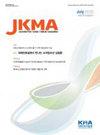女性复发性尿路感染的诊断与治疗
IF 0.5
Q3 MEDICINE, GENERAL & INTERNAL
引用次数: 1
摘要
背景:无并发症尿路感染(膀胱炎)是在初级保健诊所就诊的妇女中最常见的细菌感染,大约50%的人会复发。复发性膀胱炎对患者的生活质量、医疗费用和抗生素的过度使用造成了巨大的负担。当前观念:症状仍然是膀胱炎诊断的基石,如果怀疑膀胱炎复发,尿液培养是必要的。抗生素(通常是呋喃妥因和磷霉素)是一线治疗。根据耐药数据,头孢菌素和阿莫西林-克拉维酸是二线治疗建议。氟喹诺酮类药物不是一线选择,因为安全问题和不断上升的耐药率。在考虑复发性膀胱炎患者时,评估患者的危险因素很重要。绝经后妇女的表现可能与年轻妇女不同,需要不同的诊断和治疗方法。由于耐受性、安全性、抗菌素耐药性和患者的选择,预防复发性膀胱炎的非抗菌方法是首选。口服免疫刺激剂对任何年龄都有效,绝经后妇女也推荐阴道雌激素治疗。自启动和性交后抗生素治疗和非抗菌预防可以联合使用。对于其他治疗方案无效的妇女,可考虑低剂量持续抗生素治疗。讨论与结论:为了提高妇女的生活质量和医疗质量,缩小医生的认识与患者的需求之间的差距是必要的。此外,对复发性膀胱炎应充分利用各种预防治疗方法。本文章由计算机程序翻译,如有差异,请以英文原文为准。
Diagnosis and treatment of women with recurrent urinary tract infection
Background: Uncomplicated urinary tract infection (cystitis) is the most common bacterial infection among women visiting primary care clinics, and approximately 50% experience recurrence. Recurrent cystitis represents a substantial burden on the patients’ quality of life, healthcare costs, and antibiotics overuse.Current Concepts: Symptoms remain the cornerstone of cystitis diagnosis, and urine culture is necessary if recurrent cystitis is suspected. Antibiotics (typically nitrofurantoin and fosfomycin) are the first-line treatment. Based on the resistance data, cephalosporins and amoxicillin-clavulanate are the second-line treatment recommendations. Fluoroquinolones are not the first-line options because of safety concerns and rising resistance rates. In considering patients with recurrent cystitis, it is important to assess the patient’s risk factors. Postmenopausal women may present differently and require different diagnostic and treatment approaches from that of younger women. Non-antimicrobial approaches to prevent recurrent cystitis are preferred due to tolerability, safety, antimicrobial resistance concerns, and patient choice. Oral immunostimulant is effective for any age, and vaginal estrogen therapy is additionally recommended in postmenopausal women. Self-start and post-coital antibiotic therapy and non-antimicrobial prophylaxis may be combined. Low-dose continuous antibiotic therapy may be considered for women in whom other regimens fail.Discussion and Conclusion: To improve the quality of life and medical care of women, closing the gap between the physicians’ perceptions and patients’ needs is necessary. Furthermore, various preventive therapies for recurrent cystitis should be fully utilized.
求助全文
通过发布文献求助,成功后即可免费获取论文全文。
去求助
来源期刊

Journal of The Korean Medical Association
Medicine-General Medicine
CiteScore
0.50
自引率
0.00%
发文量
84
审稿时长
4-8 weeks
期刊介绍:
The Journal of the Korean Medical Association (JKMA) is the official peer-reviewed, open-access, monthly journal of the Korean Medical Association (KMA). It contains articles in Korean or English. Its abbreviated title is ''J Korean Med Assoc''. The aims of the Journal include contributing to the treatment of and preventing diseases of public health importance and to improvement of health and quality of life through sharing the state-of the-art scientific information on medicine by the members of KMA and other national and international societies.
 求助内容:
求助内容: 应助结果提醒方式:
应助结果提醒方式:


